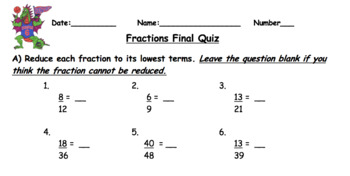Grade 5 Fractions Unit
Mr Meldrum Math and More
18 Followers
Resource Type
Standards
CCSS4.NF.A.2
CCSS4.NF.B.3b
CCSS4.NF.C.5
CCSS4.NF.C.7
Formats Included
- Word Document File
Pages
40 pages
Mr Meldrum Math and More
18 Followers
Description
This resource is a 40 page word document that contains a fractions glossary with diagrams, 4 quizzes with answer keys, and answer keys to Unit 3 of Pearsons Math Math Sense 5. It's all fully editable to suit your needs. Concepts covered in the unit include reducing fractions, equivalent fractions, ordering fractions, converting fractions to decimals, etc... This will be super useful for all intermediate math teachers, but especially useful if you teach using Math Makes Sense.
Total Pages
40 pages
Answer Key
Included
Teaching Duration
2 Weeks
Last updated Aug 4th, 2022
Report this resource to TPT
Reported resources will be reviewed by our team. Report this resource to let us know if this resource violates TPT’s content guidelines.
Standards
to see state-specific standards (only available in the US).
CCSS4.NF.A.2
Compare two fractions with different numerators and different denominators, e.g., by creating common denominators or numerators, or by comparing to a benchmark fraction such as 1/2. Recognize that comparisons are valid only when the two fractions refer to the same whole. Record the results of comparisons with symbols >, =, or <, and justify the conclusions, e.g., by using a visual fraction model.
CCSS4.NF.B.3b
Decompose a fraction into a sum of fractions with the same denominator in more than one way, recording each decomposition by an equation. Justify decompositions, e.g., by using a visual fraction model. Examples: 3/8 = 1/8 + 1/8 + 1/8; 3/8 = 1/8 + 2/8; 2 1/8 = 1 + 1 + 1/8 = 8/8 + 8/8 + 1/8.
CCSS4.NF.C.5
Express a fraction with denominator 10 as an equivalent fraction with denominator 100, and use this technique to add two fractions with respective denominators 10 and 100. For example, express 3/10 as 30/100, and add 3/10 + 4/100 = 34/100.
CCSS4.NF.C.7
Compare two decimals to hundredths by reasoning about their size. Recognize that comparisons are valid only when the two decimals refer to the same whole. Record the results of comparisons with the symbols >, =, or <, and justify the conclusions, e.g., by using a visual model.





